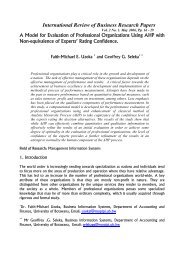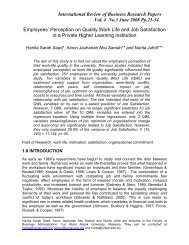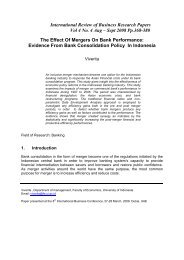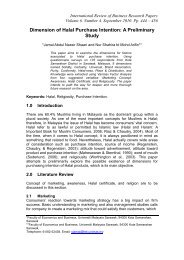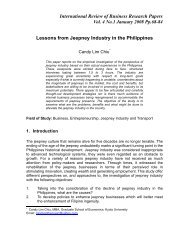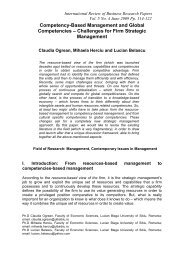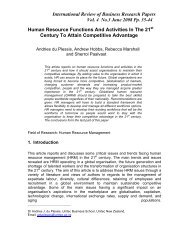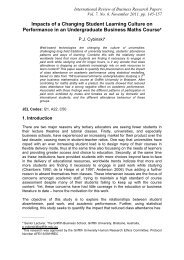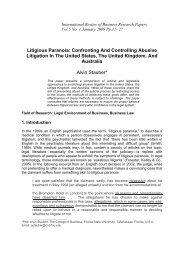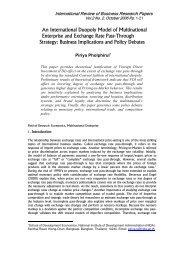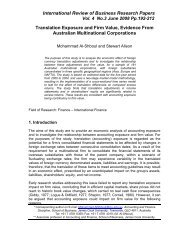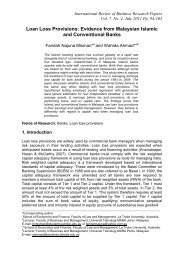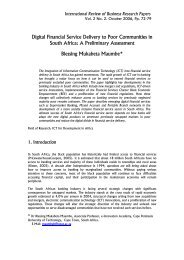Tipping Point Leadership And Its Relationship To Transformational
Tipping Point Leadership And Its Relationship To Transformational
Tipping Point Leadership And Its Relationship To Transformational
Create successful ePaper yourself
Turn your PDF publications into a flip-book with our unique Google optimized e-Paper software.
Comodromos 142research to define those qualities. Conger and Kanungo (1988,1998), Shamir et al(1993) have contributed to research on charismatic leadership in organisations byinvestigating different types of leader-follower relationships. Conger and Kanungoidentified the following factors associated with charismatic leadership; strategicvision, sensitivity to the environment, unconventional behaviour, personal risk takingand sensitivity to organisational members. Further to this research Conger andKanungo (1987, 1988, 1992) developed a model that attributed charismaticleadership to the followers’ perceptions of their leader’s behaviour. Conger andKanungo (1994 p442) differentiate ‘charismatic leaders from other leaders by theirability to formulate and articulate an inspirational vision and by behaviours andactions that foster an impression that they and their mission are extraordinary.’ Thebehavioural characteristics of tipping point leaders are similar to those of charismaticleaders in that they share inspirational visions and believe their mission to beextraordinary. The difference between the two styles lies in the perceptions of theirfollowers. Followers of charismatic leaders base their pursuit on their perception ofthe extraordinariness of the vision not on formal authority (Congo and Kanungo1994). The reasons why tipping point leaders have followers may be because theyalso share their leader’s vision but may also be because they feel intimidated intodoing so. The ‘fishbowl’ technique suggested by Kim and Mauborgne to encouragegroup compliance would require further research to clarify how effective it is insecuring loyal followers.According to Bryman (1993) ‘there is widespread confusion about the meaning ofcharismatic leadership’ and so it is difficult to be definitive about the extent of overlapbetween charismatic leadership and tipping point leadership. Yukl (1994) believes‘the most useful definition seems to be in terms of attributions of charisma to a leaderby followers who identify strongly with the leader. In this definition the originalmeaning of charisma is maintained, namely it is a gift from the gods to enable therecipient to perform extraordinary feats, and provides a basis for differentiatingbetween charismatic and tipping point leadership. Bryman’s (1992) research goes onto state that charisma is transitory. Charisma lasts as long as the leader is successfuland can be lost as conditions change. The leader’s attributions of charisma may belost once the leader’s visionary project is over. Other situations of loss can occuronce followers develop their own confidence and no longer see the reason to align totheir leader. <strong>Tipping</strong> point leadership on the other hand was designed to have alimited life span. Once the change process has been completed there no longer is aplace for tipping point and other leadership styles have to be selected. Pettigrew andWhipp (1991) account for two distinct aspects of a change program: the design andimplementation. The kind of hard leadership that is necessary to drive anorganisation towards the tipping point of accepting a new organisational paradigm isvery different from the kind of participative leadership that is necessary to facilitatethe implementation of the change process.6. ConclusionThere are many similarities between transformational, charismatic and tipping pointleadership. They share the contextual predilection for dramatic and radical changeand the extraordinary behavioural qualities of their leaders. There are also distinctdifferences in spite of overlapping similarities. <strong>Tipping</strong> point leadership is not an ongoing leadership style but one that was designed and limited to the execution of an142



